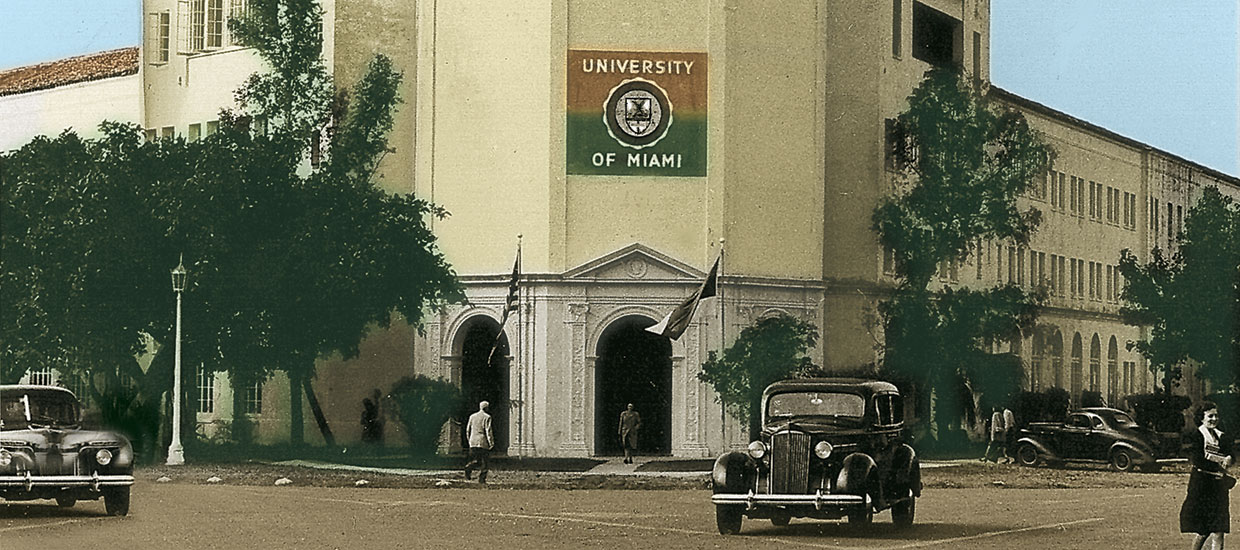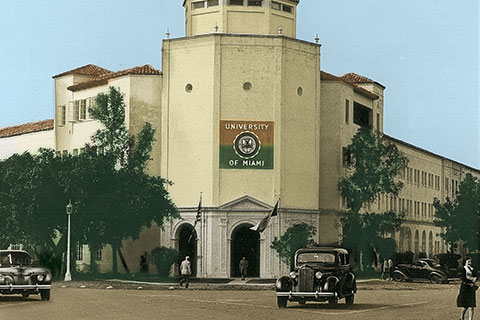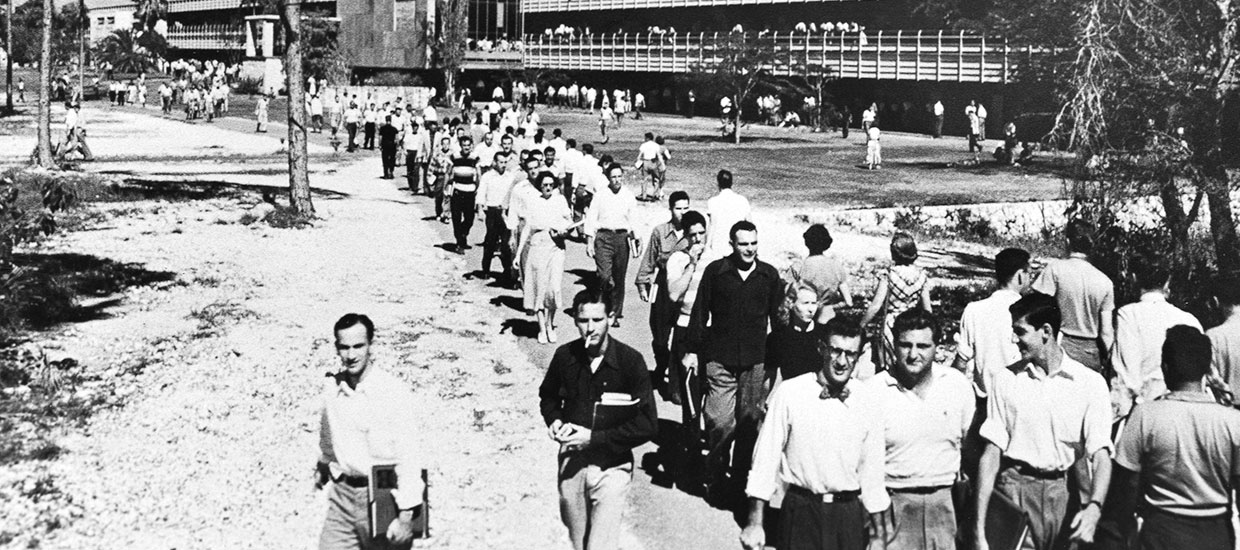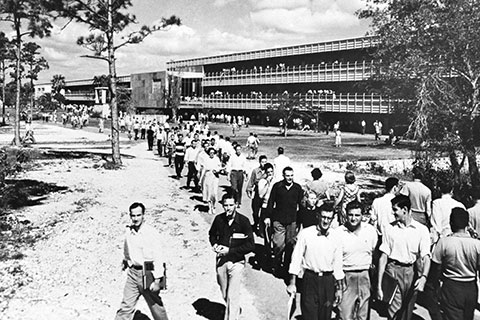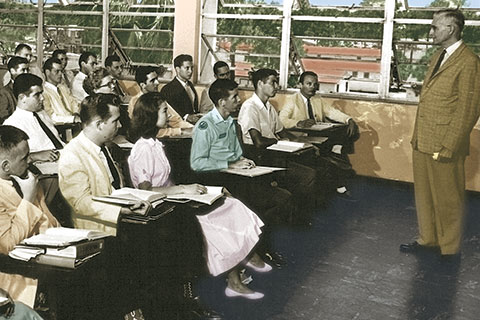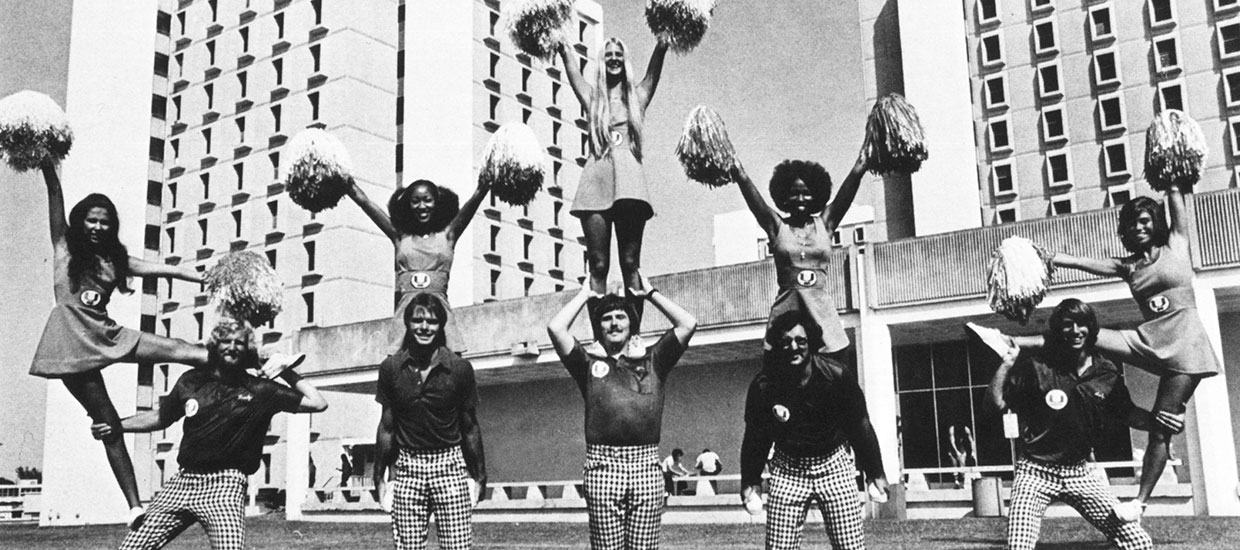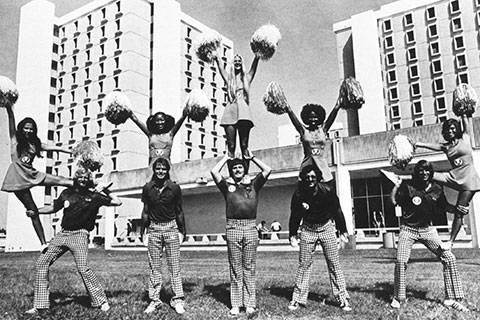The University of Miami was chartered in 1925 by Coral Gables founder George Merrick, alongside a group of visionary citizens who felt an institution of higher learning was needed for the development of their young and growing community. The South Florida land boom was at its peak, resources appeared ample, optimism flowed, and expectations were high. Supporters of the institution believed that the community offered unique opportunities to develop inter-American studies, to further creative work in the arts and letters, and to conduct teaching and research programs in tropical studies.
Early Years
In the 1920s, as South Florida experienced a period of explosive growth and optimism, a new city, Coral Gables, emerged as a bold experiment in planning and design. Conceived as a “City Beautiful,” it blended Mediterranean Revival architecture, lush landscaping, and a vision of cultural sophistication. Within this spirit of ambition and possibility, the idea for a university took shape.
The University of Miami was established in 1925, envisioned as both a cornerstone of Coral Gables and a beacon of higher education in the rapidly developing region by Coral Gables founder George Merrick. As part of the University’s establishment, Merrick gifted 160 acres of land and $5 million toward a $15 million endowment to pioneer the new institution. The University’s founders imagined an institution that would match the city’s promise—progressive, forward-looking, and deeply tied to the community it served. Support from local leaders made the dream possible, most notably through gifts of land and endowment pledges that ensured the University could open its doors.
Early renderings by architect Denman Fink captured this daring vision, their Mediterranean Revival style echoing the aesthetic of Coral Gables itself. Judge William Walsh, then chairman of the Board of Regents, recalled how those designs “staggered our imagination,” reflecting not only the scale of the project but also the audacity of its timing. Just months after the city’s founding, students and faculty gathered on what was still a fledgling campus, animated by the belief that they were helping to build something enduring.
By the fall of 1926, when the first class of 646 full-time students enrolled at the University of Miami, the land boom had collapsed, and hopes for a speedy recovery were dashed by a major hurricane. In the next 15 years the University barely kept afloat. The collapse in South Florida was a mere prelude to a national economic depression. Such were the beginnings of what has since become one of the nation’s most distinguished private universities.
The University survived primarily due to the vision and persistence of its first president, Dr. Bowman F. Ashe (1926-52). Under his administration, the institution overcame bankruptcy, a reorganization, a world war, and then in the post-war years, experienced tremendous growth and expansion.
When the University opened in 1926, it consisted of the College of Liberal Arts, the School of Music, and the Evening Division. During the Ashe presidency, the University added the School of Law (1928), the School of Business Administration (1929), the School of Education (1929), the Graduate School (1941), the Marine Laboratory (1942; presently the Rosenstiel School of Marine and Atmospheric Science), the School of Engineering (1947), and the School of Medicine (1952).
Years later, as Merrick would reflect that of all his accomplishments, he cited the University as his greatest legacy—a testament to the shared dream of a community determined to root learning and culture in the heart of South Florida.
The 1950s-1970s
Dr. Jay F. W. Pearson assumed the presidency in 1953. A marine biologist by training, charter faculty member, and an assistant to President Ashe since 1929, Dr. Pearson presided during a decade of unprecedented growth. Total enrollment stood at over 10,000 in 1953 and increased to nearly 14,000 by the end of the Pearson presidency in 1962. New facilities and resources were added to keep pace with student enrollment as well as to increase the research strength of the institution. The University also added an undergraduate honors program, expanded the graduate programs to the doctoral level in a dozen fields, established a core curriculum for undergraduates, and vastly increased its research activity.
The University entered a new epoch, a time of reexamination and consolidation under its third president, Dr. Henry King Stanford (1962-81). Stanford’s presidency was marked by further emphasis on research activity, additions to physical facilities, and reorganization of the University’s administrative structure. Several research centers and institutes were established, including the Center for Advanced International Studies (1964), the Institute of Molecular and Cellular Evolution (1964), the Center for Theoretical Studies (1965), and the Institute for the Study of Aging (1975).
1980s
In 1981, Edward T. Foote II became its fourth president. Under his leadership, the University was elected to membership in Phi Beta Kappa, the nation’s oldest and most prestigious honor society; three new schools were created—Architecture, Communication, and the Graduate School of International Studies along with its research component, the North-South Center; average SAT scores of incoming freshmen increased by nearly 100 points; and the University began and completed a series of renovations that converted standard student dormitories into a system of residential colleges.
In addition, Foote was the catalyst behind the creation of the University’s strategic plan, a blueprint for the acceleration of the University’s excellence. A five-year $400 million Campaign for the University of Miami, launched in 1984, surpassed its goal in April 1988 and ended with a $517.5 million commitment.
The 21st Century and Today
The University entered its present phase in 2001 when Donna E. Shalala became its fifth president. President Shalala was the longest serving Secretary of Health and Human Services in U.S. history. She served in the Clinton Administration from 1993-2000 and oversaw a $600 billion budget. Prior to that, she was Chancellor of the University of Wisconsin – Madison for six years, the first woman ever to head a Big Ten University. President Shalala also served as president of Hunter College, The City University of New York, for seven years. President Shalala, who spearheaded extraordinary progress in all areas, stepped down as president in May 2015.
On October 16, 2003, the University announced Momentum: The Campaign for the University of Miami, the most far-reaching and ambitious comprehensive campaign in its history. The historic fundraising drive surpassed its $1 billion goal in January 2006, a year and a half ahead of schedule, and the University established a new goal to raise an additional $250 million by the end of 2007. The campaign came to end December 31, 2007, having raised $1.4 billion‹making UM the first university in Florida to successfully mount a billion-dollar campaign.
For the sixth year in a row the University of Miami was ranked in the top 50 in U.S. News & World Report’s annual Best Colleges issue. In the 2015 report, UM is ranked No. 48 in the National Universities category. Under President Shalala’s leadership the University experienced an extraordinary rise in these popular rankings, up from No. 67 in 2001. U.S. News also listed several UM graduate programs in its 2014 America’s Best Graduate Schools rankings.
In 2012 the University publicly launched Momentum2: The Breakthrough Campaign for the University of Miami, a $1.6 billion initiative to support academic resources, learning opportunities, and strategic initiatives throughout the University. The campaign goal was reached in May 2015.
In Fall 2014 the University enrolled 16,774 students in 115 bachelor’s, 104 master’s, and 63 doctoral programs. Student selectivity for incoming freshmen continues to be highly competitive, with a mean SAT score of 1320; about half graduated in the top 5 percent of their high school class and 66 percent graduated in the top 10 percent. Enrolled students represent all 50 states and 121 other countries. UM alumni live in all 50 states and 154 countries; more than 49,000 in Miami-Dade County.
In April 2015 Dr. Julio Frenk, dean at the Harvard T.H. Chan School of Public Health and Mexico’s former minister of health, was named the University’s sixth president. A noted leader in global public health and a renowned scholar and academic, President Frenk's presidency continued until June 2024 when Joseph James Echevarria was appointed Acting President by the Board of Trustees.
Mr. Echevarria, who has served as Chief Executive Officer since 2022, was named President in October 2024. He has a long history of service to the University, including as a trustee for seven years, Chief Executive Officer of UHealth, Senior Advisor to former President Frenk, Interim Chief Financial Officer, Chief Administrative Officer, and Interim Chief Executive Officer. A lifelong ’Cane, he received a bachelor’s degree in business administration from the University of Miami in 1978.
